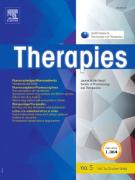Patterns of opioid analgesic prescribing in cancer outpatients during the last year of life in France: A pharmacoepidemiological cohort study based on the French health insurance database - 11/06/22
 , Bérangère Baricault a, Maryse Lapeyre-Mestre a, b, c
, Bérangère Baricault a, Maryse Lapeyre-Mestre a, b, cCet article a été publié dans un numéro de la revue, cliquez ici pour y accéder
Summary |
Cancer pain management with adequate analgesics for cancer outpatients can be particularly challenging. This representative retrospective cohort study aimed to investigate the prevalence and timing of weak and strong opioid analgesic prescriptions in cancer outpatients during their last year of life, with a focus on factors associated to potential late strong opioid initiation. Factors associated with late strong opioid initiation were investigated through multivariate logistic regression analyses stratified by place of death. A retrospective cohort of cancer outpatients, who died between 2014 and 2016, was identified from the general sample of beneficiaries. Among N=4704 cancer patients (median age 76 years, 42.7% women), 3002 (63.8%) were prescribed and dispensed ≥1 weak or strong opioid analgesic during their last year of life; of whom, 2458 (52.3%) received ≥1 weak opioid analgesic (tramadol as single-ingredient accounting for 25.9%) and 1733 (36.8%) ≥1 strong opioid analgesic dispensation (fentanyl 21.6%). Median interval between the first prescription for any strong opioid and death was 18 weeks (interquartile range: 8-38), and for weak opioids 33 weeks (interquartile range: 20-47). Among weak opioid users, 1229 (50.0%) patients had received ≥1 weak opioid analgesic dispensation during the year n-2 before death. Among strong opioid users, 986 (56.9%) patients had received ≥1 weak opioid analgesic dispensation during the year n-2 before death and 381 (21.9%) patients ≥1 strong opioid analgesic dispensation. Patients with an outpatient death were more likely to have a late strong opioid initiation compared to patients with an inpatient death. Late strong opioid initiation (<18 weeks before death) was significantly associated with a lower number of hospitalization days and prior weak opioid exposure for patients with an inpatient death and, with older age, social, prior weak opioid exposure, and a prescription initiation by general practitioner for patients with an outpatient death. Our gained knowledge of opioid prescribing patterns in cancer patients during the last year of life might help to progress opioid analgesic treatment and to improve patient outcomes.
Le texte complet de cet article est disponible en PDF.Keywords : Opioid analgesics, Cancer, End-of-life, Outpatients, Initiation
Plan
Bienvenue sur EM-consulte, la référence des professionnels de santé.
L’accès au texte intégral de cet article nécessite un abonnement.
Déjà abonné à cette revue ?

